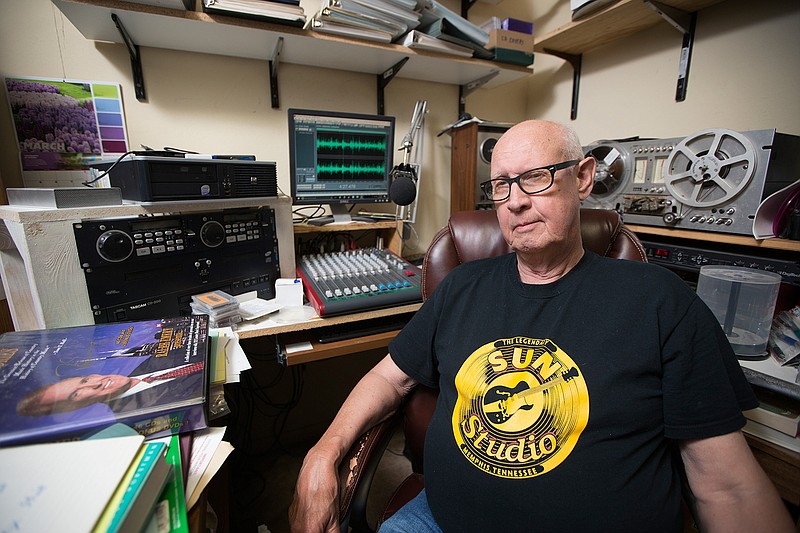For Doug Davis, a song isn't just the lyrics sung and the instrumental accompaniment. It's also the story behind how it came alive.
Davis, a longtime music writer and musician in his own right, pens a weekly column for the Texarkana Gazette and also delights thousands of additional readers with his "Country Music Classics" email newsletter. He's spun country tunes as a radio deejay here for decades.
For Davis' faithful readers and listeners, the columnist and on-air personality stirs the memory with old songs they treasure fondly.
At his Texas-side home, Doug's office is filled with musical history, whether it's shelves crammed full of LPs or old recording equipment that recalls an era of bygone technologies. It's here where he records radio shows, too, using his computer, and where he simply writes.
"Just junk I've collected in the last 70 years," Davis says modestly of what's around him. A garage and storage buildings out back contain more music. He's a pack rat, but now that he's getting on in years he realizes it's time to downsize his life and trim the collection. He hates to think about it but knows the time is coming.
"Years and years ago, I started really counting and I got tired at 5,000 and quit," Davis recalled about tallying his albums. He recalls trading and buying when he could first afford it back in high school.
Still, he continues to find more. On top of a freshly-purchased stack of LPs sat a Jimmy Work record, "Making Believe." Davis attends estate sales with his wife.
His interest in country music, you might say, originated in soap operas. That's what his mother listened to on the radio.
"Of course they had singing jingles, you know, and commercials," said Davis, a self-described "little bitty squirt" back then. "I remember asking her, 'How's those guys get in that little box?'" She explained they weren't actually inside the radio but rather in New York City or San Francisco and other places. They were broadcasting.
Young Davis asked if people got paid to do that. Yes, they did-quite well, in fact-and so his interest was sparked. The first radio station he saw was KTFS here in Texarkana. "I was just mesmerized," he recalls.
Now, so many decades later, he's still a deejay, part-time, for KPIG FM. He records classic country and gospel shows for the station, plus a short form piece called "The Story Behind the Song" that runs on a dozen stations across the country. He did a morning show up until a year ago, when he decided he'd like to sleep in a bit in the morning.
His first radio job was the late 1950s at KTFS. "I worked for the guy who worked overnight. I made the coffee and ripped the news off the old teletype machine. You remember the old black clunkers?" They were the source for news at radios and newspapers.
In his early years in the business, he worked an all-night gig. As a young man, the hours didn't phase him. "The more the merrier," he said. The three Texarkana radio stations back then, he worked for them all: KOSY, KCMC and KTFS. He worked radio in Idabel, Okla., for a while, too.
"When I started, you walked into a radio station and you had turntables, cart machines, reel-to-reel," Davis recalled. Carts were the forerunner to 8-track tapes with an endless loop to record commercials and play them back. Now, things are different.
"Computers have taken over the world. Sometimes I think that's not too good, but that's the way it is anyway," Davis said.
For him, it was and still is all about classic country. There's a reason for that.
"I just like that old way back in the early '50s and '60s what they call the 4/4 shuffle beat music," Davis said. "Old Ray Price records, that kind of stuff." This style enticed him to fall for country music. "I loved it then, I still do. I never get tired of it."
It's the kind of music he and some other gentlemen perform weekly at local retirement centers. "We play the nursing home circuit every Friday morning," he said. He plays the guitar, a self-described "flustered guitar player." He suffered a stroke that makes it tougher, but he still wants to play for the people.
"I don't have sense enough to give up, to quit," Davis, sporting a black Sun Studio T-shirt, admits with good humor.
His "Story Behind the Song" idea originated from phone interviews he did for the radio way back in the early 1960s. He recorded them. "I kept those tapes all this time," he says. Then, he realized, there wasn't anything like it in newspapers, so the idea was born.
At the Gazette, he convinced editor J.Q. Mahaffey to carry a column. Although it didn't pay much, he just wanted to do it. He's written for the paper here off and on ever since.
For a while, Davis wrote for a syndicate that sold his column to other newspapers around the nation. Eventually, his column became part of a weekend entertainment package distributed for the weekend editions of various papers. He did a column for them titled "Sound Country," he recalls.
"It was at one time running in 1,200 papers across the country," Davis said. It was a news biz highlight.
In the late '90s, he became interested in computers. He claims he's not a computer geek, but he noticed people started sending email newsletters. A "cooking freak" sent him one about cooking. That inspired him to start his own, "Country Music Classics."
"Printed out it's about seven or eight pages," Davis said. He started with seven subscribers. "Today I have over 20,000. That's all free. I don't try to make a dollar out of it. It's just something I love to do."
And his readers share his love for music.
"To them, it brings back memories. One of my subscribers is 96 years old, lives in Baltimore, Md.," Davis said. The email goes out overnight Wednesday night into Thursday morning. That subscriber is the first recipient he hears from. "She almost every email says, 'Mr. Davis, you've done it again. I sit hear just crying reading your newsletter because it brings back so many wonderful memories.'"
The work has thus introduced him to both nice people and interesting characters. And for Davis, enjoying the column writing is all about a sense of history.
"I enjoy digging up the information. I love research if it's something I like and I like this. That's what I really like about it is researching," Davis said. Many of his columns deal with the artist, songwriter or producer, and many of those industry folks he interviewed himself.
"I tell these guys, I said, I don't care what your favorite food is, your favorite color, how many kids you have, if you drink, smoke dope, I could care less. I want to know where the idea for this song came from. That's the whole idea, that's what interests me. How'd this thing get on record?" Davis says.
Along the way, he ran out of interviews, so he had to do more of them. He estimates he's conducted about 200 interviews.
"Some of the most interesting people to talk to were Jerry Reed, for one," Davis said. "Of course, he's known as a wild man."
Reed was a Chet Atkins protege and told Davis that Chet Atkins was the reason he was doing what he did for a living. Reed also told him about the song "Misery Loves Company," a song he wrote for Porter Wagoner.
"He said, 'It's kind of funny how that came about. I never even thought of that song before I wrote it,'" Davis said. Reed, waiting around for an appointment one day, just came up with the song, impromptu-style. For Wagoner, it became a No. 1 hit.
"That's what turns me on. That's my thing," Davis said of the research, the story behind these songs.


